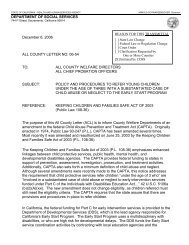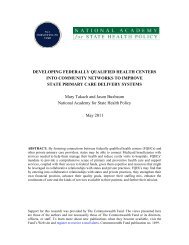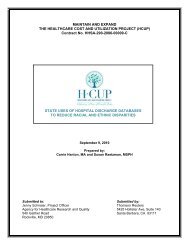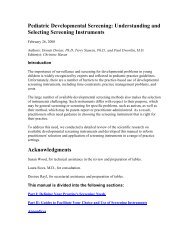Improving Care Coordination, Case Management, and Linkages to
Improving Care Coordination, Case Management, and Linkages to
Improving Care Coordination, Case Management, and Linkages to
Create successful ePaper yourself
Turn your PDF publications into a flip-book with our unique Google optimized e-Paper software.
Critical Characteristics of High Performing Pediatric <strong>Care</strong> <strong>Coordination</strong><br />
The foundational characteristics <strong>and</strong> attributes of excellent pediatric care coordination include the following:<br />
1. Patient <strong>and</strong> Family-centered<br />
• Links patients <strong>and</strong> families <strong>to</strong> an accessible, community-based primary care Medical Home<br />
2 Pro-active, Planned, <strong>and</strong> Comprehensive<br />
• Supports anticipa<strong>to</strong>ry, proactive, continuous <strong>and</strong> longitudinal care<br />
• Builds upon family strengths <strong>and</strong> is guided by a comprehensive, st<strong>and</strong>ardized assessment of needs<br />
• Supports <strong>and</strong> relies upon team care<br />
• Facilitates the care planning process including consultation, referral, testing, goals (jointly developed <strong>and</strong><br />
shared), moni<strong>to</strong>ring <strong>and</strong> follow-up<br />
• Plans for the transition of youth from pediatric <strong>to</strong> adult systems of care<br />
3. Promotes Self <strong>Care</strong> Skills <strong>and</strong> Independence<br />
• <strong>Care</strong> coordination ensures the provision of patient/family education <strong>to</strong> build self-management skills<br />
• <strong>Care</strong> coordination seeks <strong>to</strong> equip families with the necessary skills <strong>to</strong> navigate a complex health care system<br />
4. Emphasizes Cross Organizational Relationships<br />
• <strong>Care</strong> coordination builds strategic relationships across a community which support integration of care <strong>and</strong><br />
patient/youth/family self-management skills<br />
• <strong>Care</strong> coordination assures effective communication <strong>and</strong> collaboration back <strong>and</strong> forth along the continuum<br />
of care<br />
An<strong>to</strong>nelli RC, McAllister JW, <strong>and</strong> Popp J. Developing <strong>Care</strong> <strong>Coordination</strong> as a Critical Component of a High Performance Pediatric Health <strong>Care</strong> System:<br />
Forging a Multidisciplinary Framework for Pediatric <strong>Care</strong> <strong>Coordination</strong>. (In press) The Commonwealth Fund, forthcoming 2009.<br />
26<br />
concept in 10 states (three practices per state) <strong>and</strong> by building capacity for state Title V programs, which promote,<br />
sustain <strong>and</strong> spread improvements after the project period is completed. Because the medical home model<br />
dealt with care coordination <strong>and</strong> linkages between services <strong>and</strong> supports, these programs demonstrate how<br />
<strong>to</strong> use existing agencies <strong>and</strong> infrastructure <strong>to</strong> disseminate the medical home model <strong>and</strong> support linkages. One<br />
national study assessed the feasibility of implementing a bundle of Bright Futures 74 recommendations <strong>and</strong> evaluated<br />
a modified learning collaborative’s effectiveness in improving preventive <strong>and</strong> developmental care. The results<br />
demonstrated significant changes across a learning collaborative. 75<br />
Several states provide outst<strong>and</strong>ing examples of state-level child health quality improvement. Vermont <strong>and</strong> Utah<br />
are among those with focused efforts.<br />
The Vermont Child Health Improvement Program (VCHIP)—a program of the University of Vermont Department<br />
of Pediatrics, in collaboration with the Vermont Department of Health <strong>and</strong> the Vermont chapter of the American<br />
Academy of Pediatrics—has demonstrated the broad effectiveness of a statewide quality improvement outreach<br />
project. VCHIP engaged most pediatric providers in the state. The program’s mission is <strong>to</strong> optimize the health of<br />
Vermont’s children by initiating <strong>and</strong> supporting measurement-based efforts <strong>to</strong> enhance private <strong>and</strong> public child<br />
health practice. 76 One VCHIP project demonstrates how an effective statewide pediatric quality improvement outreach<br />
program can improve preventive services for children 5 years old. 77 VCHIP has designed <strong>and</strong> shared a model<br />
for “improvement partnerships” that consist of public <strong>and</strong> private collaboratives that use measurement-based<br />
efforts <strong>and</strong> a systems approach <strong>to</strong> improve the quality of children’s health care. Improvement partnerships can ad-<br />
<strong>Improving</strong> <strong>Care</strong> <strong>Coordination</strong>, <strong>Case</strong> <strong>Management</strong>, <strong>and</strong> <strong>Linkages</strong> <strong>to</strong> Service for Young Children: Opportunities for States<br />
National Academy for State Health Policy
















